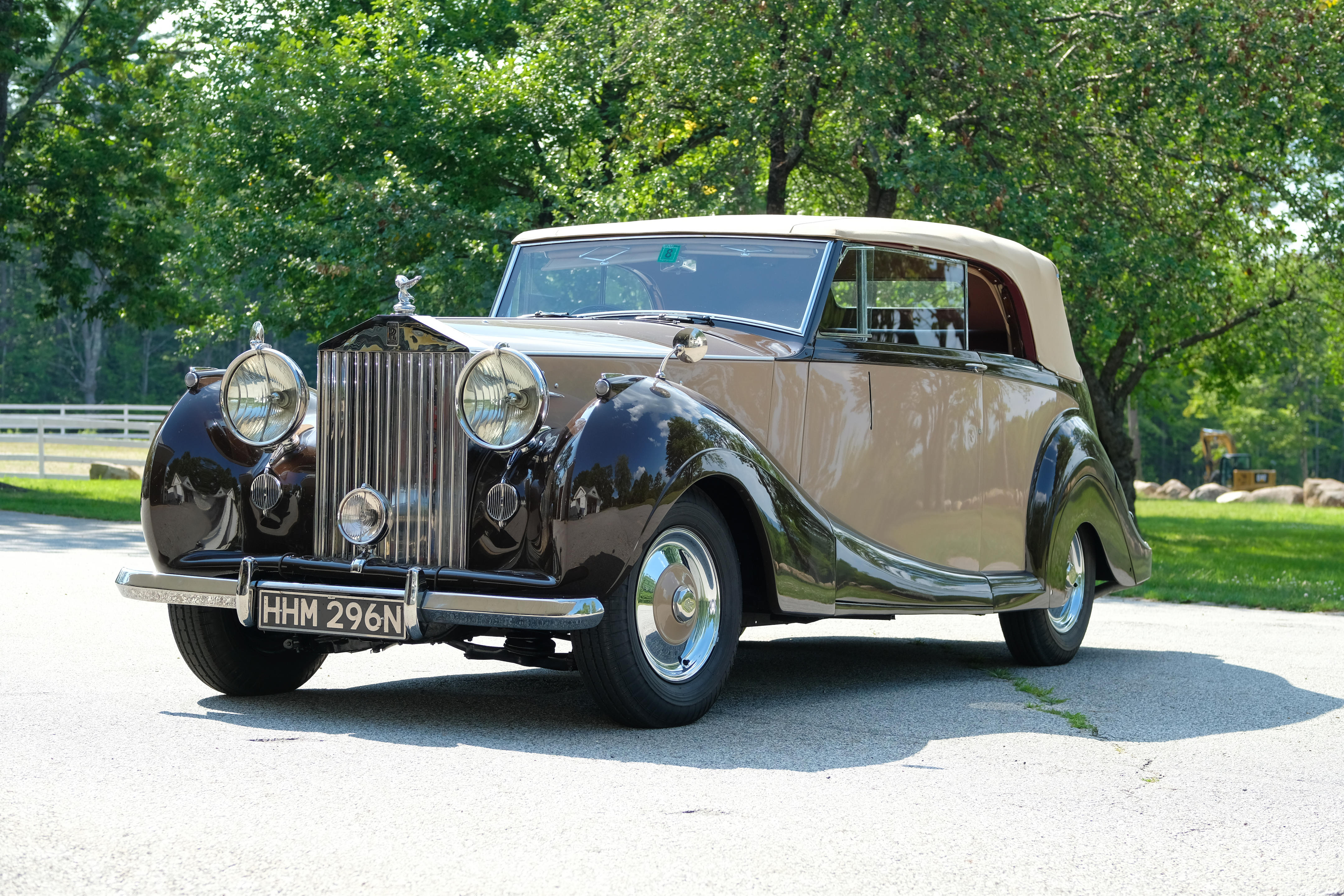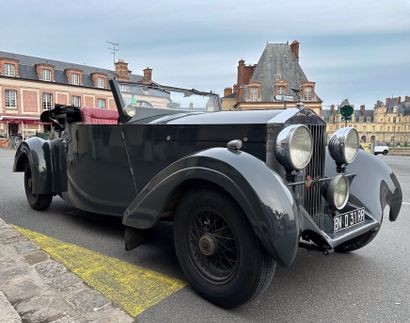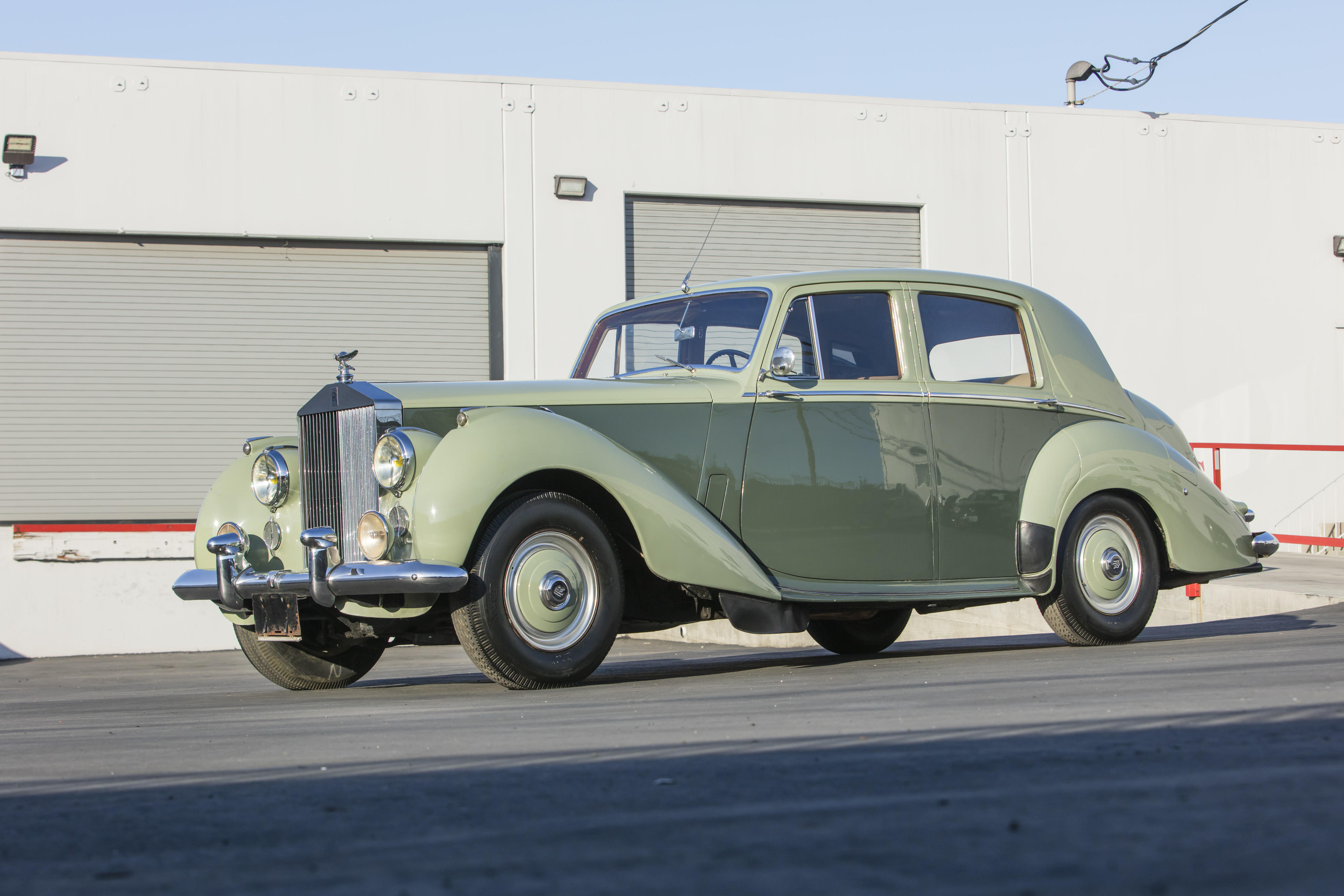4,257cc F-head Inline Six-cylinder Engine
Single Dual-choke Stromberg Carburetor
135 bhp
4-Speed Manual Transmission
Independent Front Suspension with Coil Springs, Live Rear Axle with Semi-elliptic Springs, Driver-controlled Dampers
4-wheel Hydraulic Drum Brakes
*Matching numbers
*Documented by the Rolls-Royce Owners' Club Foundation
*Restored in 2017
*Featured on the cover of "Rolls-Royce, the Classic Elegance"
*Award winner at the 2018 Greenwich Concours d'Elegance
THE ROLLS-ROYCE SILVER WRAITH
The Silver Wraith was the first model offered by Rolls Royce Ltd. after World War II, with production running from 1946 to 1958 at the company's former Merlin engine factory in Crewe. It was also the last Rolls-Royce model that would be delivered in "chassis only" for completion by independent body fabricators. The Silver Wraith thus marked the end of the coach-built Rolls Royce era. In the company's own words, the Silver Wraith was "considered by many to be the most technologically advanced Rolls Royce model in history...an exceptionally graceful and elegant automobile." The Silver Wraith chassis was manufactured in lettered series, "A" through "H" being short-chassis (200 inches on a 127-inch wheelbase) in the late 1940s and "A" through "H" in long-chassis (206 inches on a 133-inch wheelbase) in the 1950s. The shorter version was most suited to close-coupled, or sporting models, open or closed, with the longer chassis better accommodated formal sedans and limousines. Silver Wraiths were built on an improved and strengthened ladder frame, considerably more rigid than its predecessors, and based on that of the pre-war Wraith. The independent front suspension was coil-sprung and the live rear axle was located by semi-elliptic springs.
The engine was also based on the pre-war Wraith, utilizing a cylinder head with overhead inlet valves and side exhaust valves. The initial capacity was 4,257 cc and produced 135 horsepower. A dry clutch and a four-speed manual gearbox with column shift sent power to the driving wheels. For the first time, the drum brakes were vacuum-and servo-assisted.
Silver Wraiths, as with pre-war models, were delivered as rolling chassis, to be completed by one of a range of select custom coachbuilders to a customer's specification. Not many of those remained after the war, as Rolls-Royce and Bentley were laying plans to standardize their body designs. Still, these independent coachbuilders, whether domestic, Continental, or even American, offered a wide range of bespoke body styles, finishes, and accessories from which a client could choose.
THE MOTORCAR OFFERED
The handsome example offered here, WFC4, was the fourth in the short-chassis "C" Series manufactured in 1948-1950 and comprising 100 units. In his marque appreciation entitled "Rolls-Royce, the Classic Elegance", Mr. Lawrence Dalton states that WFC4 was among ten short-chassis Wraiths ordered by John "Jack" Barclay Rolls Royce-Bentley of London. These chassis were then sent to either Gurney Nutting and Co. or James Young Ltd. to be clothed in similar very elegant Drop-head coupé bodywork. Reflecting its importance, WFC4 is featured on the cover of Mr. Dalton's tome.
Barclay, closely linked to the famous "Bentley Boys", opened as a Bentley dealer in 1927 and a decade later purchased coachbuilder James Young Ltd. At war's end, Barclay expanded with the acquisition of coachbuilder J. Gurney Nutting and Company, with the goal of making roadworthy again as many as possible of the Rolls-Royce and Bentley automobiles that had been laid up in storage during the conflict. Gurney Nutting had developed a well-earned reputation for designing stylish and finely-constructed coachwork and interiors. Gurney Nutting craftsmen also built the famed Le Mans-winning 1929 "Old Number One" Bentley Speed Six and Sir Malcolm Campbell's "Bluebird" land-speed racer of the 1930s.
The details and provenance of this fine, well-traveled Rolls-Royce Silver Wraith are well-documented; records obtained from the Rolls-Royce Owners' Club Foundation reveals that WFC4 left the works at Crewe on January 12, 1949. It appears from the original factory build sheet to have been finished in Green with Buff hide interior trim and a Fawn convertible top. There is also mention of special-ordered step-irons. The Gurney Nutting body was numbered 2008 and based on Design number WR20M. Bernard King's "Rolls-Royce Silver Dawn and Silver Wraith" (page 162) states that another Gurney Nutting Drophead Coupé of this design was built for Sir Vincent de Ferranti in March 1950, bearing chassis number WDC100. Martin Bennet's "Rolls-Royce Silver Wraith" (page 336), shows a third chassis, WFC14, built in July of 1949 with the same Gurney Nutting bodywork design for a Mr. S. Kapur. Over the years, this lovely body style with its semi-skirted rear fenders has been variously described as simply a Drop-head Coupé, a Three-position Drop-head Coupé, a Sedanca deVille, and by Rolls-Royce as a "Drophead Foursome Coupé".
The chassis' completion date is shown to be January 12, 1949 and the finished car was delivered to the owner on October 26 of that year through Charles Attwood and Sons in Wolverhampton, England. The original buyer of this car is listed as a Mr. G. Hall of "The Woodlands", also in Wolverhampton and it was registered as HHM296N.
According to Rolls-Royce Owners' Club documents, including its type-written (but un-dated) Schoellkopf card, WFC4 came to the United States by at least the early- to mid-1960s, as it is shown in the RROC Membership Directory of 1966-67 as being in the custody of noted collector Walter Wolfson of New Brunswick New Jersey. The car then apparently returned to the UK where it was acquired circa December 1, 1974 by Mr. Rodney D.P. Mitchell of Clipston, Market Harborough. The bodywork by then had been changed to Brown over Cream, the color scheme that enhances it today. It was offered the same year by Charles Howard, but it is not clear whether that preceded Mr. Drake's ownership. Mr. Paul W. Morgan of West Chester, Pennsylvania is shown as an owner until 1981. WFC4 again crossed the Atlantic, passing into the hands of Frank Dale and Stepsons of London circa March 24, 1982.
WFC4 then found its way back to the collection of Mr. Mitchell, who registered it in Hong Kong, where he spent a great deal of time. It was registered there on February 2, 1989 as EC580. More overseas travel was in the offing; Mr. M. Johnson of Dallas, Texas bought this car from a Gerry Porter in Kensington. Mr. Johnson registered it in Texas on October 7, 1994. The current custodian, a noted New Hampshire collector, acquired this automobile in 2008.
Under the care of the current owner, the car was fully restored at great expense, estimated by the owner as in excess of $250,000. The coachwork and new paint in Brown over Tan were completed by Competition Motors in Portsmouth, New Hampshire, and the mechanical aspects by the Vintage Garage in Stowe, Vermont. Soon after its restoration, the owner entered it in the Greenwich Concours d'Elegance where it attracted many admirers and received a class award. The owner says it has been driven very few miles since, and is very smooth and quiet.
This stunning Silver Wraith offers many charming features, including a chromed hand-crank and trafficators in the doors, rather in the cowling. It is ready for its next appearance on the Concours field, and would be a capstone to any serious collection of fine ports-war European classics.
4,257cc F-head Inline Six-cylinder Engine
Single Dual-choke Stromberg Carburetor
135 bhp
4-Speed Manual Transmission
Independent Front Suspension with Coil Springs, Live Rear Axle with Semi-elliptic Springs, Driver-controlled Dampers
4-wheel Hydraulic Drum Brakes
*Matching numbers
*Documented by the Rolls-Royce Owners' Club Foundation
*Restored in 2017
*Featured on the cover of "Rolls-Royce, the Classic Elegance"
*Award winner at the 2018 Greenwich Concours d'Elegance
THE ROLLS-ROYCE SILVER WRAITH
The Silver Wraith was the first model offered by Rolls Royce Ltd. after World War II, with production running from 1946 to 1958 at the company's former Merlin engine factory in Crewe. It was also the last Rolls-Royce model that would be delivered in "chassis only" for completion by independent body fabricators. The Silver Wraith thus marked the end of the coach-built Rolls Royce era. In the company's own words, the Silver Wraith was "considered by many to be the most technologically advanced Rolls Royce model in history...an exceptionally graceful and elegant automobile." The Silver Wraith chassis was manufactured in lettered series, "A" through "H" being short-chassis (200 inches on a 127-inch wheelbase) in the late 1940s and "A" through "H" in long-chassis (206 inches on a 133-inch wheelbase) in the 1950s. The shorter version was most suited to close-coupled, or sporting models, open or closed, with the longer chassis better accommodated formal sedans and limousines. Silver Wraiths were built on an improved and strengthened ladder frame, considerably more rigid than its predecessors, and based on that of the pre-war Wraith. The independent front suspension was coil-sprung and the live rear axle was located by semi-elliptic springs.
The engine was also based on the pre-war Wraith, utilizing a cylinder head with overhead inlet valves and side exhaust valves. The initial capacity was 4,257 cc and produced 135 horsepower. A dry clutch and a four-speed manual gearbox with column shift sent power to the driving wheels. For the first time, the drum brakes were vacuum-and servo-assisted.
Silver Wraiths, as with pre-war models, were delivered as rolling chassis, to be completed by one of a range of select custom coachbuilders to a customer's specification. Not many of those remained after the war, as Rolls-Royce and Bentley were laying plans to standardize their body designs. Still, these independent coachbuilders, whether domestic, Continental, or even American, offered a wide range of bespoke body styles, finishes, and accessories from which a client could choose.
THE MOTORCAR OFFERED
The handsome example offered here, WFC4, was the fourth in the short-chassis "C" Series manufactured in 1948-1950 and comprising 100 units. In his marque appreciation entitled "Rolls-Royce, the Classic Elegance", Mr. Lawrence Dalton states that WFC4 was among ten short-chassis Wraiths ordered by John "Jack" Barclay Rolls Royce-Bentley of London. These chassis were then sent to either Gurney Nutting and Co. or James Young Ltd. to be clothed in similar very elegant Drop-head coupé bodywork. Reflecting its importance, WFC4 is featured on the cover of Mr. Dalton's tome.
Barclay, closely linked to the famous "Bentley Boys", opened as a Bentley dealer in 1927 and a decade later purchased coachbuilder James Young Ltd. At war's end, Barclay expanded with the acquisition of coachbuilder J. Gurney Nutting and Company, with the goal of making roadworthy again as many as possible of the Rolls-Royce and Bentley automobiles that had been laid up in storage during the conflict. Gurney Nutting had developed a well-earned reputation for designing stylish and finely-constructed coachwork and interiors. Gurney Nutting craftsmen also built the famed Le Mans-winning 1929 "Old Number One" Bentley Speed Six and Sir Malcolm Campbell's "Bluebird" land-speed racer of the 1930s.
The details and provenance of this fine, well-traveled Rolls-Royce Silver Wraith are well-documented; records obtained from the Rolls-Royce Owners' Club Foundation reveals that WFC4 left the works at Crewe on January 12, 1949. It appears from the original factory build sheet to have been finished in Green with Buff hide interior trim and a Fawn convertible top. There is also mention of special-ordered step-irons. The Gurney Nutting body was numbered 2008 and based on Design number WR20M. Bernard King's "Rolls-Royce Silver Dawn and Silver Wraith" (page 162) states that another Gurney Nutting Drophead Coupé of this design was built for Sir Vincent de Ferranti in March 1950, bearing chassis number WDC100. Martin Bennet's "Rolls-Royce Silver Wraith" (page 336), shows a third chassis, WFC14, built in July of 1949 with the same Gurney Nutting bodywork design for a Mr. S. Kapur. Over the years, this lovely body style with its semi-skirted rear fenders has been variously described as simply a Drop-head Coupé, a Three-position Drop-head Coupé, a Sedanca deVille, and by Rolls-Royce as a "Drophead Foursome Coupé".
The chassis' completion date is shown to be January 12, 1949 and the finished car was delivered to the owner on October 26 of that year through Charles Attwood and Sons in Wolverhampton, England. The original buyer of this car is listed as a Mr. G. Hall of "The Woodlands", also in Wolverhampton and it was registered as HHM296N.
According to Rolls-Royce Owners' Club documents, including its type-written (but un-dated) Schoellkopf card, WFC4 came to the United States by at least the early- to mid-1960s, as it is shown in the RROC Membership Directory of 1966-67 as being in the custody of noted collector Walter Wolfson of New Brunswick New Jersey. The car then apparently returned to the UK where it was acquired circa December 1, 1974 by Mr. Rodney D.P. Mitchell of Clipston, Market Harborough. The bodywork by then had been changed to Brown over Cream, the color scheme that enhances it today. It was offered the same year by Charles Howard, but it is not clear whether that preceded Mr. Drake's ownership. Mr. Paul W. Morgan of West Chester, Pennsylvania is shown as an owner until 1981. WFC4 again crossed the Atlantic, passing into the hands of Frank Dale and Stepsons of London circa March 24, 1982.
WFC4 then found its way back to the collection of Mr. Mitchell, who registered it in Hong Kong, where he spent a great deal of time. It was registered there on February 2, 1989 as EC580. More overseas travel was in the offing; Mr. M. Johnson of Dallas, Texas bought this car from a Gerry Porter in Kensington. Mr. Johnson registered it in Texas on October 7, 1994. The current custodian, a noted New Hampshire collector, acquired this automobile in 2008.
Under the care of the current owner, the car was fully restored at great expense, estimated by the owner as in excess of $250,000. The coachwork and new paint in Brown over Tan were completed by Competition Motors in Portsmouth, New Hampshire, and the mechanical aspects by the Vintage Garage in Stowe, Vermont. Soon after its restoration, the owner entered it in the Greenwich Concours d'Elegance where it attracted many admirers and received a class award. The owner says it has been driven very few miles since, and is very smooth and quiet.
This stunning Silver Wraith offers many charming features, including a chromed hand-crank and trafficators in the doors, rather in the cowling. It is ready for its next appearance on the Concours field, and would be a capstone to any serious collection of fine ports-war European classics.














Try LotSearch and its premium features for 7 days - without any costs!
Be notified automatically about new items in upcoming auctions.
Create an alert